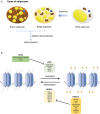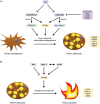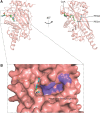Regulation of Thermogenic Adipocyte Differentiation and Adaptive Thermogenesis Through Histone Acetylation
- PMID: 32174890
- PMCID: PMC7057231
- DOI: 10.3389/fendo.2020.00095
Regulation of Thermogenic Adipocyte Differentiation and Adaptive Thermogenesis Through Histone Acetylation
Abstract
Over the past decade, the increasing prevalence of obesity and its associated metabolic disorders constitutes one of the most concerning healthcare issues for countries worldwide. In an effort to curb the increased mortality and morbidity derived from the obesity epidemic, various therapeutic strategies have been developed by researchers. In the recent years, advances in the field of adipocyte biology have revealed that the thermogenic adipose tissue holds great potential in ameliorating metabolic disorders. Additionally, epigenetic research has shed light on the effects of histone acetylation on adipogenesis and thermogenesis, thereby establishing the essential roles which histone acetyltransferases (HATs) and histone deacetylases (HDACs) play in metabolism and systemic energy homeostasis. In regard to the therapeutic potential of thermogenic adipocytes for the treatment of metabolic diseases, herein, we describe the current state of knowledge of the regulation of thermogenic adipocyte differentiation and adaptive thermogenesis through histone acetylation. Furthermore, we highlight how different HATs and HDACs maintain the epigenetic transcriptional network to mediate the pathogenesis of various metabolic comorbidities. Finally, we provide insights into recent advances of the potential therapeutic applications and development of HAT and HDAC inhibitors to alleviate these pathological conditions.
Keywords: adaptive thermogenesis; epigenetics; gene expression; histone acetylation; histone acetyltransferase inhibitors; histone deacetylase inhibitors; histone deacetylation; thermogenic adipocyte differentiation.
Copyright © 2020 Ong, Brunmeir, Zhang, Peng, Idris, Liu and Xu.
Figures







Similar articles
-
The Histone Demethylase UTX Promotes Brown Adipocyte Thermogenic Program Via Coordinated Regulation of H3K27 Demethylation and Acetylation.J Biol Chem. 2015 Oct 9;290(41):25151-63. doi: 10.1074/jbc.M115.662650. Epub 2015 Aug 25. J Biol Chem. 2015. PMID: 26306033 Free PMC article.
-
Role of histone acetyltransferases and histone deacetylases in adipocyte differentiation and adipogenesis.Eur J Cell Biol. 2014 Apr;93(4):170-7. doi: 10.1016/j.ejcb.2014.03.001. Epub 2014 Mar 25. Eur J Cell Biol. 2014. PMID: 24810880 Review.
-
Epigenomic Control of Thermogenic Adipocyte Differentiation and Function.Int J Mol Sci. 2018 Jun 17;19(6):1793. doi: 10.3390/ijms19061793. Int J Mol Sci. 2018. PMID: 29914202 Free PMC article. Review.
-
Histone Deacetylase 1 (HDAC1) Negatively Regulates Thermogenic Program in Brown Adipocytes via Coordinated Regulation of Histone H3 Lysine 27 (H3K27) Deacetylation and Methylation.J Biol Chem. 2016 Feb 26;291(9):4523-36. doi: 10.1074/jbc.M115.677930. Epub 2016 Jan 5. J Biol Chem. 2016. PMID: 26733201 Free PMC article.
-
DOT1L Regulates Thermogenic Adipocyte Differentiation and Function via Modulating H3K79 Methylation.Diabetes. 2021 Jun;70(6):1317-1333. doi: 10.2337/db20-1110. Epub 2021 Apr 1. Diabetes. 2021. PMID: 33795413
Cited by
-
Acute Kidney Injury Results in Long-Term Diastolic Dysfunction That Is Prevented by Histone Deacetylase Inhibition.JACC Basic Transl Sci. 2021 Feb 22;6(2):119-133. doi: 10.1016/j.jacbts.2020.11.013. eCollection 2021 Feb. JACC Basic Transl Sci. 2021. PMID: 33665513 Free PMC article.
-
Browning of the white adipose tissue regulation: new insights into nutritional and metabolic relevance in health and diseases.Nutr Metab (Lond). 2022 Sep 6;19(1):61. doi: 10.1186/s12986-022-00694-0. Nutr Metab (Lond). 2022. PMID: 36068578 Free PMC article. Review.
-
Roles of Protein Post-Translational Modifications During Adipocyte Senescence.Int J Biol Sci. 2023 Oct 16;19(16):5245-5256. doi: 10.7150/ijbs.86404. eCollection 2023. Int J Biol Sci. 2023. PMID: 37928271 Free PMC article. Review.
-
Long non-coding RNA (LncRNA) and epigenetic factors: their role in regulating the adipocytes in bovine.Front Genet. 2024 Oct 3;15:1405588. doi: 10.3389/fgene.2024.1405588. eCollection 2024. Front Genet. 2024. PMID: 39421300 Free PMC article. Review.
-
Rewriting cellular fate: epigenetic interventions in obesity and cellular programming.Mol Med. 2024 Oct 10;30(1):169. doi: 10.1186/s10020-024-00944-2. Mol Med. 2024. PMID: 39390356 Free PMC article. Review.
References
-
- Hales CM, Carroll MD, Fryar CD, Ogden CL. Prevalence of obesity among adults and youth: United States, 2015-2016. NCHS Data Brief.(2017) 1–8. Available online at: https://www.cdc.gov/nchs/data/databriefs/db288.pdf - PubMed
-
- World Health Organization Global patterns of health risk. Global Health Risks: Mortality and Burden of Disease Attributable to Selected Major Risks. Geneva: World Health Organization; (2009). p. 9–12.
Publication types
MeSH terms
Substances
LinkOut - more resources
Full Text Sources
Miscellaneous

